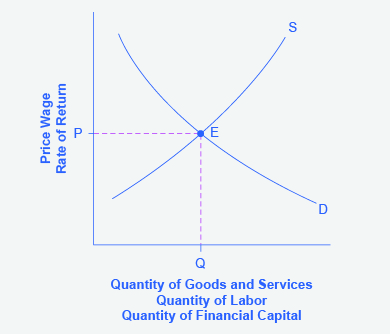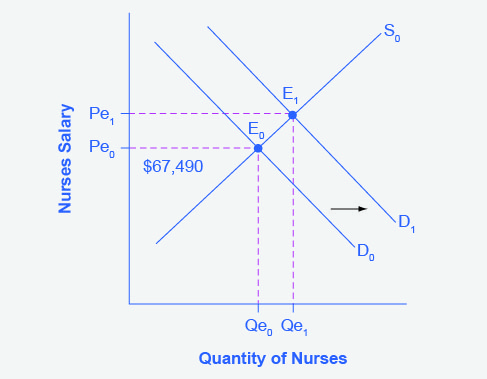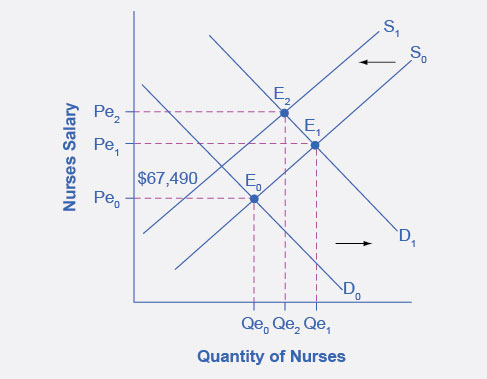1.6 – The Market System as an Efficient Mechanism for Information
Learning Objectives
- Apply demand and supply models to analyze prices and quantities
- Explain the effects of price controls on the equilibrium of prices and quantities
Prices exist in markets for goods and services, for labour, and for financial capital. In all of these markets, prices serve as a remarkable social mechanism for collecting, combining, and transmitting information that is relevant to the market—namely, the relationship between demand and supply—and then serving as messengers to convey that information to buyers and sellers. In a market-oriented economy, no government agency or guiding intelligence oversees the set of responses and interconnections that result from a change in price. Instead, each consumer reacts according to that person’s preferences and budget set, and each profit-seeking producer reacts to the impact on its expected profits. The following Clear It Up feature examines the demand and supply models.
Clear It Up
Why are demand and supply curves important?
The demand and supply model is the second fundamental diagram for this course. (The opportunity set model that we introduced in the Choice in a World of Scarcity chapter was the first.) Just as it would be foolish to try to learn the arithmetic of long division by memorizing every possible combination of numbers that can be divided by each other, it would be foolish to try to memorize every specific example of demand and supply in this chapter, this textbook, or this course. Demand and supply is not primarily a list of examples. It is a model to analyze prices and quantities. Even though demand and supply diagrams have many labels, they are fundamentally the same in their logic. Your goal should be to understand the underlying model so you can use it to analyze any market.
Figure 1.6a displays a generic demand and supply curve. The horizontal axis shows the different measures of quantity: a quantity of a good or service, or a quantity of labour for a given job, or a quantity of financial capital. The vertical axis shows a measure of price: the price of a good or service, the wage in the labour market, or the rate of return (like the interest rate) in the financial market.
The demand and supply model can explain the existing levels of prices, wages, and rates of return. To carry out such an analysis, think about the quantity that will be demanded at each price and the quantity that will be supplied at each price—that is, think about the shape of the demand and supply curves—and how these forces will combine to produce equilibrium.
We can also use demand and supply to explain how economic events will cause changes in prices, wages, and rates of return. There are only four possibilities: the change in any single event may cause the demand curve to shift right or to shift left, or it may cause the supply curve to shift right or to shift left. The key to analyzing the effect of an economic event on equilibrium prices and quantities is to determine which of these four possibilities occurred. The way to do this correctly is to think back to the list of factors that shift the demand and supply curves. Note that if more than one variable is changing at the same time, the overall impact will depend on the degree of the shifts. When there are multiple variables, economists isolate each change and analyze it independently.

In the same way, price changes provide useful information to producers. Imagine the situation of a farmer who grows oats and learns that the price of oats has risen. The higher price could be due to an increase in demand caused by a new scientific study proclaiming that eating oats is especially healthful. Perhaps the price of a substitute grain, like corn, has risen, and people have responded by buying more oats. The oat farmer does not need to know the details. The farmer only needs to know that the price of oats has risen and that it will be profitable to expand production as a result.
The actions of individual consumers and producers as they react to prices overlap and interlock in markets for goods, labour, and financial capital. A change in any single market is transmitted through these multiple interconnections to other markets. The vision of the role of flexible prices helping markets to reach equilibrium and linking different markets together helps to explain why price controls can be so counterproductive. Price controls are government laws that serve to regulate prices rather than allow the various markets to determine prices. There is an old proverb: “Don’t kill the messenger.” In ancient times, messengers carried information between distant cities and kingdoms. When they brought bad news, there was an emotional impulse to kill the messenger. However, killing the messenger did not kill the bad news. Moreover, killing the messenger had an undesirable side effect: Other messengers would refuse to bring news to that city or kingdom, depriving its citizens of vital information.
Those who seek price controls are trying to kill the messenger—or at least to stifle an unwelcome message that prices are bringing about the equilibrium level of price and quantity. However, price controls do nothing to affect the underlying forces of demand and supply, and this can have serious repercussions. During China’s “Great Leap Forward” in the late 1950s, the government kept food prices artificially low, with the result that 30 to 40 million people died of starvation because the low prices depressed farm production. This was communist party leader Mao Zedong’s social and economic campaign to rapidly transform the country from an agrarian economy to a socialist society through rapid industrialization and collectivization. Changes in demand and supply will continue to reveal themselves through consumers’ and producers’ behavior. Immobilizing the price messenger through price controls will deprive everyone in the economy of critical information. Without this information, it becomes difficult for everyone—buyers and sellers alike—to react in a flexible and appropriate manner as changes occur throughout the economy.
Bring It Home
Baby Boomers Come of Age
The theory of supply and demand can explain what happens in the labour markets and suggests that the demand for nurses will increase as healthcare needs of baby boomers increase, as Figure 1.6b shows. The impact of that increase will result in an average salary higher than the $67,490 earned in 2015 referenced in the first part of this case. The new equilibrium (E1) will be at the new equilibrium price (Pe1).Equilibrium quantity will also increase from Qe0 to Qe1.

Figure 1.6b Impact of Increasing Demand for Nurses 2014-2024 Text Version
The vertical axis is nurses salary (P) and the horizontal axis is the quantity of nurses (Q). The supply curve (S0) is a straight line trending upwards from left to right and the demand curve (D0) is a straight line trending upwards from left to right. The Equilibrium (E0) occurs where S0 and D0 intersect at point Qe0 and Pe0 . As demand for services increases, the demand curve shifts to the right from D0 to D1 . The equilibrium quantity of nurses increases from Qe0 to Qe1 and the equilibrium salary increases from Pe0 to Pe1. The new equilibrium (E1) occurs where S0 and D1 intersect at point Qe1 and Pe1.
Suppose that as the demand for nurses increases, the supply shrinks due to an increasing number of nurses entering retirement and increases in the tuition of nursing degrees. The leftward shift of the supply curve in Figure 1.6c captures the impact of a decreasing supply of nurses. The shifts in the two curves result in higher salaries for nurses, but the overall impact in the quantity of nurses is uncertain, as it depends on the relative shifts of supply and demand.

Figure 1.6c Impact of Decreasing Supply of Nurses between 2014 and 2024 Text Version
The same as Figure 4.10: The vertical axis is nurses salary (P) and the horizontal axis is the quantity of nurses (Q). The supply curve (S0) is a straight line trending upwards from left to right and the demand curve (D0) is a straight line trending upwards from left to right. The Equilibrium (E0) occurs where S0 and D0 intersect at point Qe0 and Pe0 . As demand for services increases, the demand curve shifts to the right from D0 to D1 . The equilibrium quantity of nurses increases from Qe0 to Qe1 and the equilibrium salary increases from Pe0 to Pe1. The new equilibrium (E1) occurs where S0 and D1 intersect at point Qe1 and Pe1.
As nurses retire from the work force, the supply of nurses decreases causing a leftward shift in the supply curve, from S0 to S1. The equilibrium salary increases from Pe1 to Pe2 and the equilibrium quantity of nurses is uncertain shifting to left from Qe1 to Qe2 , but is still more than the initial Qe0 . The equilibrium shifts from E1 to E2 occurring where S1 and D1 intersect at point Qe2 and Pe2.
While we do not know if the number of nurses will increase or decrease relative to their initial employment, we know they will have higher salaries.
Key Concepts & Summary
The market price system provides a highly efficient mechanism for disseminating information about relative scarcities of goods, services, labour, and financial capital. Market participants do not need to know why prices have changed, only that the changes require them to revisit previous decisions they made about supply and demand. Price controls hide information about the true scarcity of products and thereby cause misallocation of resources.
Attribution
Except where otherwise noted, this chapter is adapted from “The Market System as an Efficient Mechanism for Information” and “Key Concepts and Summary” In Principles of Microeconomics 2e (Open Stax) by Steven A. Greenlaw & David Shapiro licensed under CC BY 4.0./ Adaptations include addition of key concepts and summary.
Access for free at Principles of Microeconomics 2e
Original Source Chapter References
American Community Survey. 2012. “School Enrollment and Work Status: 2011.” Accessed April 13, 2015. http://www.census.gov/prod/2013pubs/acsbr11-14.pdf.
National Center for Educational Statistics. “Digest of Education Statistics.” (2008 and 2010). Accessed December 11, 2013. nces.ed.gov.
CreditCards.com. 2013. http://www.creditcards.com/credit-card-news/credit-card-industry-facts-personal-debt-statistics-1276.php.
Media Attributions
- 7fcc913a62b0f82b5cbda70cd269a6b503f8258c © Steven A. Greenlaw & David Shapiro (OpenStax) is licensed under a CC BY (Attribution) license
- 19a7e8ccdd1aef2d52096ca2708df638978562a3 © Steven A. Greenlaw & David Shapiro (OpenStax) is licensed under a CC BY (Attribution) license
- ad6a6436b311cb82ddc371cdd25af062eefccc7c © Steven A. Greenlaw & David Shapiro (OpenStax) is licensed under a CC BY (Attribution) license

